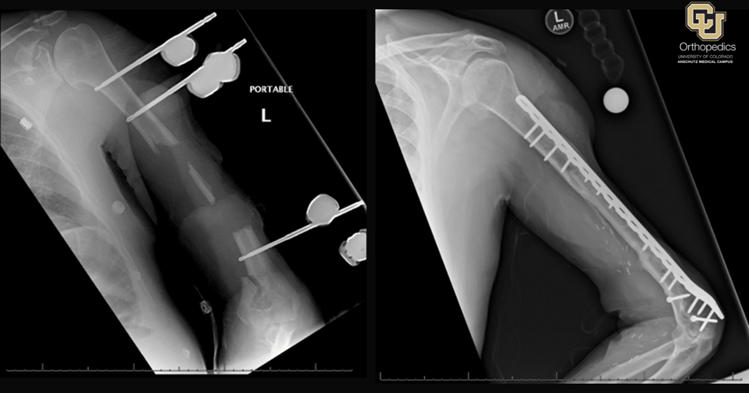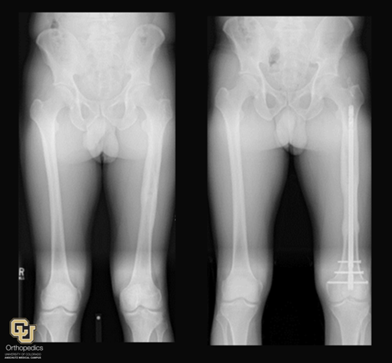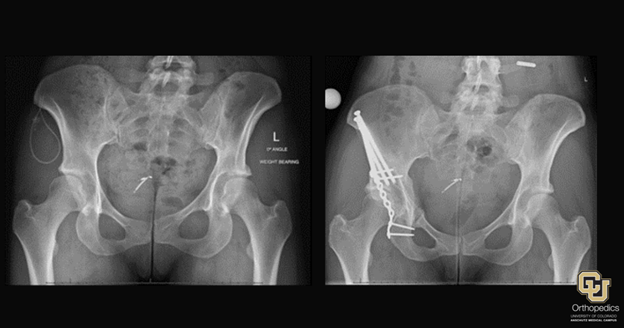What is a Bone or Fracture Nonunions?
What is a Bone or Fracture Nonunion?
A fracture nonunion is the incomplete healing of a fracture where the sides of the bone fragments
do not reconnect. Nonunions commonly present with persistent pain, swelling, or instability beyond the time when healing should normally have occurred. In most cases, symptomatic nonunions are treated with surgery.
Although not very common, failure of bone fracture healing resulting in a nonunion occurs in 5% to 10% of patients. According to studies, the highest nonunion rates occur in the tibia or fibula (14%) and femur (13.9%).
There are 4 types of a Bone Nonunion:
- Hypertrophic: The bone nonunion still has blood flow (vascularized) and callus formation can be seen on X-rays
- Oligotrophic: The bone nonunion is vascularized but there is no callus formation seen on x-rays.
- Atrophic: The bone with the nonunion does not have blood flow (avascular) and there is no evidence of callus formation in their x-rays.
- Pseudarthrosis: The bone nonunion has adequate vascularization (blood flow) but has excess motion and instability.

This patient had a fracture nonunion in the left humerus (upper arm) bone, shown on the left. It was repaired by the Limb Restoration Program using a bone graft from the patient’s fibula.

This is an example of a torsional (rotated) malunion in a patient’s femur, shown on the left. It was corrected using an osteotomy (a cut into the bone) that allowed the bone to rotate to a normal position, as shown on the right.
Risk Factors for Bone Nonunions and Malunions
There are two categories of risk factors: non-modifiable (things we can’t change) and modifiable (things we can change).
Non-modifiable risk factors for bone or fracture nonunions and malunions include:
- Open fractures
- Multiple fractures
- Fracture associated with severe soft tissue injury
- Poor blood supply to the fractured bone
- Poor bone fixation (ie, excessive movement at the fracture site or fragment ends too far from one another)
- Diabetes (especially type 1)
- Diabetes with associated peripheral neuropathy
- Immunosuppression
- Osteoporosis
- Malignance
Modifiable Risk Factors for Bone or Fracture Nonunions and Malunions Include:
- Tobacco use
- Chronic alcohol use
- Infection (you do not need to feel sick to have infected bone)
- Obesity
- Malnutrition
- Vitamin D and Calcium deficiency
- Certain medications (such as Advil, Aleve, Celebrex, and many others)
- Thyroid gland disease

This patient was originally treated for hip dysplasia, shown on the left, but the original surgery resulted in a nonunion. Their nonunion was corrected by the Limb Restoration Program, shown on the right.
Drugs that May Impair Fracture Healing, Resulting in Nonunions or Malunions
- Nonsteroidal anti-inflammatory drugs (NSAIDs) or COX-2 selective agents, such as Ibuprofen, Aleve, Motrin, Aspirin, Celebrex
- Glucocorticoids (Prednisone, Dexamethasone) are known to impair bone metabolism and reduce bone density. This medication is the most common cause of secondary osteoporosis. The effects may be dose-dependent.
- Select antibiotics: multiple fluoroquinolones (ciprofloxacin, levofloxacin) have been implicated in impaired fracture healing and may cause a nonunion. The mechanism is thought to involve effects on cartilage growth and production. Decrease cellular proliferation and DNA synthesis was noted, therefore the new cells are the most affected.
- Bisphosphonates (example: Alendronate): Authors suggest that these drugs may arrest bone remodeling during fracture healing stages and ultimately impede or significantly slow down normal bone healing.
- Chemotherapy agents: Some chemotherapeutic medications inhibit rapidly reproducing cells, and these may impair normal bone healing following a fracture, potentially causing a malunion or nonunion. The University of Colorado Limb Restoration Program will not adjust your chemotherapy treatment and instead seek other treatment options.
- Some HIV medications
How Are Nonunions and Malunions Treated?
Although we can’t cure medical conditions such as diabetes, thyroid issues, or osteoporosis, there is a lot that can be done to improve your chances of healing a fracture. Fracture nonunions and malunions are often treated with reconstructive surgery, but there are several steps we take to ensure you are in the best possible position to heal safely:
- The University of Colorado Limb Restoration Program team will order bloodwork to detect and correct modifiable risk factors.
- You may need a deep bone biopsy to check if there is an underlying infection, especially if you have an open (exposed) fracture.
- Tobacco use is known to impede bone metabolism and increase the chance of postoperative infection. Healing time is longer for nicotine users. Because of this, nicotine usage is not recommended until surgery is completed and you are fully healed.
- A CT scan prior to nonunion surgery is needed to adequately plan your malunion or nonunion repair.
- We may refer you to the Bone Metabolic Specialist or a nutrition specialist to provide a multidisciplinary approach to achieve the best outcomes. We work with multiple specialties and will direct care to our multidisciplinary teammates as needed.

This patient had a fracture nonunion repaired in their humerus (arm bone), shown on the left. The nonunion was repaired by the Limb Restoration Program using a bone graft and fixation with pins, shown on the right.
Take the Next Step Towards Good Health
If you are experiencing a malunion, nonunion, or another condition that is affecting your limbs or has caused you limb loss, please contact our clinic to discuss your health.
Practice Location
CU Limb Restoration Program - University of Colorado Hospital
1635 Aurora Court Anschutz Outpatient Pavilion, 4th floor,Aurora, CO 80045
To make an appointment call:
Phone: 1-844-800-LIMB (5462)
Fax: 720-553-0402
E-Mail: [email protected]
For urgent or emergency transfers, call the Access Center at:
Phone: (720) 848-2828